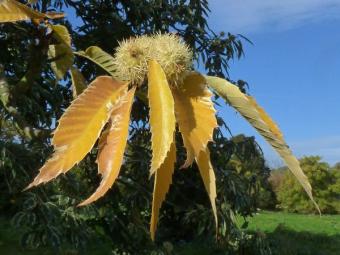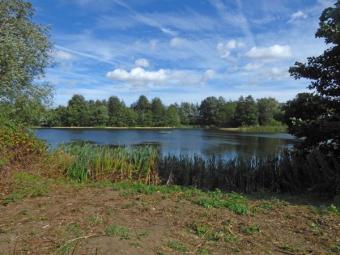 LakeOur Bees trip today was to a familiar haunt for our group- North Cave Wetlands. The weather was unpromising when we departed from the Unitarian church in Bradford, dull with some drizzle however it brightened up on our arrival and our day ended in sunshine. We were aware of the ever present breezes on the reserve but they did not cause any problems more especially for our journey home. Birds, butterflies, dragonflies, hedgerows with berries and late flowering plants were our menu for the day as we did a walk along the perimeter path of the reserve. The visit was between seasons and definitely had an autumn twist. Birds are variously on their migration path.
LakeOur Bees trip today was to a familiar haunt for our group- North Cave Wetlands. The weather was unpromising when we departed from the Unitarian church in Bradford, dull with some drizzle however it brightened up on our arrival and our day ended in sunshine. We were aware of the ever present breezes on the reserve but they did not cause any problems more especially for our journey home. Birds, butterflies, dragonflies, hedgerows with berries and late flowering plants were our menu for the day as we did a walk along the perimeter path of the reserve. The visit was between seasons and definitely had an autumn twist. Birds are variously on their migration path.
Birds- the main subject of interest were the Kestrels. Our group spent some considerable time observing them in flight, hovering above potential prey and then swiftly descending for the catch, their brilliant auburn-brown backs shinning in the sunlight. The lakes were noticeably lacking in water as a result of drought conditions of summer. There was a presence of Greylag Geese in good numbers, also ducks including Teal, Gadwall, Tufted duck, Pintail, Pochard and Wigeon. Great and Little Grebe were seen as well as Heron, Cormorant, Little Egret, Mute Swan and it's Australian relative the Black Swan. However waders were seen in limited numbers including Snipe, Little Ringed Plover, Lapwing and Ruff.
Butterflies - a variety of butterflies were seen including Speckled Wood,(dancing along the rides), Small White, Comma, Small Copper, Red Admiral and Wall.
Dragonflies- were seen busy patrolling the perimeter paths and around the dragonfly ponds. They included Migrant Hawker and Common Darter dragonflies.
Hedgerows and flowers- the hedgerows were fully laden with berries of Dogwood, Hawthorn, Buckthorn and Rowan. No doubt they will be stripped as winter descends. However the Blackberries were seen to have suffered from the drought. They were not as round or delicious as the ones at Arnside. Of the 70 flowers recorded by Alice 75% were in flower the rest in fruit. Notable plants were Common Fleabane, Viper's-bugloss, Mignonette also the pinks- Stork's-bill, Field Bindweed, Common Centaury and Mallow( seen in single numbers). The undoubted highlight of the day ( apart from Barbara's trousers seen at ground level) was the Grass Snake spotted by Sally swimming along the margin of the Main Lake from the overlooking hide. John has confirmed it's identity.
This field visit was attended by 10 people and for several it was their first visit to this popular reserve. Thanks go to our drivers Sue and Kevin and also to Alice and Margaret for planning our day. So sad to say "good bye " to summer. Margaret
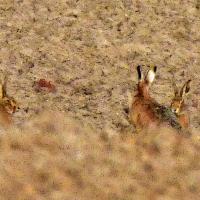 Twelve members of the group set off from the Unitarian church in Bradford on this cold, winter morning to head east for our visit to Burton Agnes gardens. It was a long two hour drive however we were in the safe hands of Kevin and Sue.
Twelve members of the group set off from the Unitarian church in Bradford on this cold, winter morning to head east for our visit to Burton Agnes gardens. It was a long two hour drive however we were in the safe hands of Kevin and Sue.
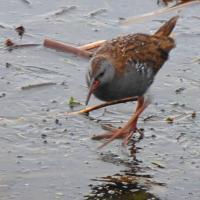 Julia had been keeping a close eye on local starling murmurations in recent weeks as she tried to decide where today's destination should be. Notification was received on the day preceding our visit that Leighton Moss was the favoured site and so, on a misty morning, 12 of us left Bradford a little later than normal to visit this popular RSPB reserve. Fortunately conditions had improved by the time we reached Silverdale where it was agreed that the Causeway Hide would be our first port of call. As we crossed the boardwal
Julia had been keeping a close eye on local starling murmurations in recent weeks as she tried to decide where today's destination should be. Notification was received on the day preceding our visit that Leighton Moss was the favoured site and so, on a misty morning, 12 of us left Bradford a little later than normal to visit this popular RSPB reserve. Fortunately conditions had improved by the time we reached Silverdale where it was agreed that the Causeway Hide would be our first port of call. As we crossed the boardwal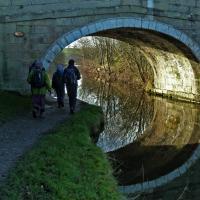 Nine members enjoyed a New Year walk of 4.5km. Led by Donald, we followed a circular route from Gargrave along the towpath of the Leeds - Liverpool canal and returned across fields along a section of the Pennine Way. Predictions from Donald of good weather, wet grass and mud were all upheld. Blue sky and sunshine accompanied us all day. The pace was slow, ideally suitable to admire the reflections in the canal and to appreciate the beauty of nature as a new year begins.After the razz ma tazz of a modern Christmas the peace and quiet were more than welcome.
Nine members enjoyed a New Year walk of 4.5km. Led by Donald, we followed a circular route from Gargrave along the towpath of the Leeds - Liverpool canal and returned across fields along a section of the Pennine Way. Predictions from Donald of good weather, wet grass and mud were all upheld. Blue sky and sunshine accompanied us all day. The pace was slow, ideally suitable to admire the reflections in the canal and to appreciate the beauty of nature as a new year begins.After the razz ma tazz of a modern Christmas the peace and quiet were more than welcome.